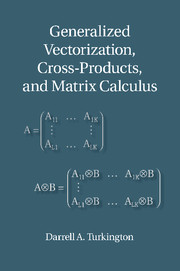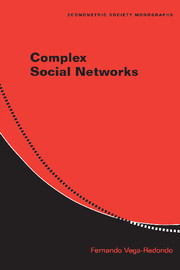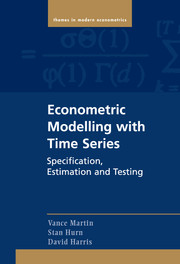Refine search
Actions for selected content:
2584 results in Computational Science
Copyright page
-
- Book:
- Generalized Vectorization, Cross-Products, and Matrix Calculus
- Published online:
- 05 February 2013
- Print publication:
- 11 February 2013, pp iv-iv
-
- Chapter
- Export citation
Five - New Matrix Calculus Results
-
- Book:
- Generalized Vectorization, Cross-Products, and Matrix Calculus
- Published online:
- 05 February 2013
- Print publication:
- 11 February 2013, pp 164-213
-
- Chapter
- Export citation
Preface
-
- Book:
- Generalized Vectorization, Cross-Products, and Matrix Calculus
- Published online:
- 05 February 2013
- Print publication:
- 11 February 2013, pp ix-xii
-
- Chapter
- Export citation

Generalized Vectorization, Cross-Products, and Matrix Calculus
-
- Published online:
- 05 February 2013
- Print publication:
- 11 February 2013

Complex Social Networks
-
- Published online:
- 05 January 2013
- Print publication:
- 08 January 2007

Econometric Modelling with Time Series
- Specification, Estimation and Testing
-
- Published online:
- 05 January 2013
- Print publication:
- 28 December 2012
Seven new champion linear codes
- Part of
-
- Journal:
- LMS Journal of Computation and Mathematics / Volume 16 / October 2013
- Published online by Cambridge University Press:
- 01 January 2013, pp. 109-117
-
- Article
-
- You have access
- Export citation
Appendix D - Additional Nonparametric Results
-
- Book:
- Econometric Modelling with Time Series
- Published online:
- 05 January 2013
- Print publication:
- 28 December 2012, pp 857-864
-
- Chapter
- Export citation
2 - Properties of Maximum Likelihood Estimators
- from PART ONE - Maximum Likelihood
-
- Book:
- Econometric Modelling with Time Series
- Published online:
- 05 January 2013
- Print publication:
- 28 December 2012, pp 33-86
-
- Chapter
- Export citation
PART SIX - Nonlinear Time Series
-
- Book:
- Econometric Modelling with Time Series
- Published online:
- 05 January 2013
- Print publication:
- 28 December 2012, pp 713-714
-
- Chapter
- Export citation
12 - Estimation by Simulation
- from PART THREE - Other Estimation Methods
-
- Book:
- Econometric Modelling with Time Series
- Published online:
- 05 January 2013
- Print publication:
- 28 December 2012, pp 432-464
-
- Chapter
- Export citation
20 - Nonlinearities in Variance
- from PART SIX - Nonlinear Time Series
-
- Book:
- Econometric Modelling with Time Series
- Published online:
- 05 January 2013
- Print publication:
- 28 December 2012, pp 758-811
-
- Chapter
- Export citation
9 - Quasi-Maximum Likelihood Estimation
- from PART THREE - Other Estimation Methods
-
- Book:
- Econometric Modelling with Time Series
- Published online:
- 05 January 2013
- Print publication:
- 28 December 2012, pp 307-351
-
- Chapter
- Export citation
4 - Hypothesis Testing
- from PART ONE - Maximum Likelihood
-
- Book:
- Econometric Modelling with Time Series
- Published online:
- 05 January 2013
- Print publication:
- 28 December 2012, pp 119-154
-
- Chapter
- Export citation
Contents
-
- Book:
- Econometric Modelling with Time Series
- Published online:
- 05 January 2013
- Print publication:
- 28 December 2012, pp ix-xx
-
- Chapter
- Export citation
6 - Nonlinear Regression Models
- from PART TWO - Regression Models
-
- Book:
- Econometric Modelling with Time Series
- Published online:
- 05 January 2013
- Print publication:
- 28 December 2012, pp 194-227
-
- Chapter
- Export citation
5 - Linear Regression Models
- from PART TWO - Regression Models
-
- Book:
- Econometric Modelling with Time Series
- Published online:
- 05 January 2013
- Print publication:
- 28 December 2012, pp 157-193
-
- Chapter
- Export citation
Author Index
-
- Book:
- Econometric Modelling with Time Series
- Published online:
- 05 January 2013
- Print publication:
- 28 December 2012, pp 877-880
-
- Chapter
- Export citation
8 - Heteroskedastic Regression Models
- from PART TWO - Regression Models
-
- Book:
- Econometric Modelling with Time Series
- Published online:
- 05 January 2013
- Print publication:
- 28 December 2012, pp 272-304
-
- Chapter
- Export citation
PART ONE - Maximum Likelihood
-
- Book:
- Econometric Modelling with Time Series
- Published online:
- 05 January 2013
- Print publication:
- 28 December 2012, pp 1-2
-
- Chapter
- Export citation













